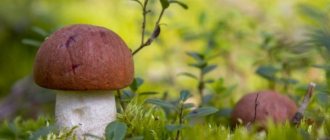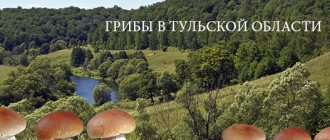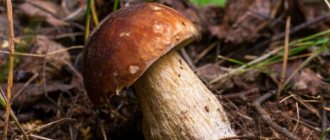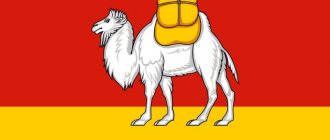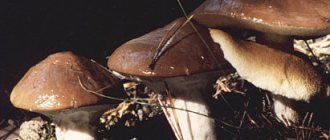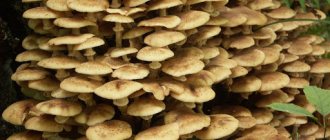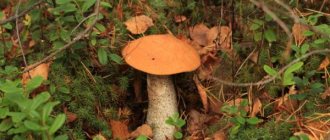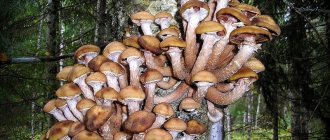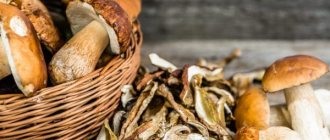Kazakhstan is a country with rich natural potential and beautiful landscapes. There is a diverse flora and fauna here, many mushroom places in which experienced mushroom pickers collect a large harvest of forest gifts. Warm periods after rains, but without dry weather, are especially rich in harvest, and in the warm regions of the country, mushroom pickers find forest gifts almost all year round. More information about where and in what places to collect mushrooms in Kazakhstan, and what mushrooms grow in this region, will be discussed in this article.
Where to look for mushrooms
The collection season begins in the last ten days of April. The first to appear in the steppes are bigheads, then morel caps in aspen groves (until mid-May). Since July, champignons, boletus, boletus, and boletus are found in abundance. Most mushroom finds are found in coniferous and deciduous forests. From the end of August, the first oyster mushrooms, capsicums, and russula appear. In areas with mild, warm winters, mushroom pickers harvest until the end of autumn and even at the beginning of winter.
August and September are the peak of the mushroom season; at this time, valui, row, saffron milk caps, chanterelles, boletus, milk mushrooms, honey mushrooms and porcini mushrooms are found almost everywhere. Winter honey mushrooms (flammulina) are also found in November-December; they grow on dead trees and even under snow. These mushrooms are not afraid of frost and sub-zero temperatures.
Malaysary Ridge
The Malaysary ridge is located 120 km north of Almaty. Malaysary is the westernmost spur of the Dzhungar Alatau mountain range. It stretches from east to west for about 80 km. The width of the ridge does not exceed 5 km. The relative height is up to 500 m, the absolute height reaches 1100 m above sea level. The mushroom season in Malaysary usually begins at the end of April, when average daily temperatures reach +10 degrees and above.
Map of Kazakhstan.
In addition to Malaysara, mushroom pickers advise looking within a radius of 100-200 kilometers from the city, for example, the Assy plateau, Kordai Pass. They also write that the harvest of porcini mushrooms, champignons and milk mushrooms can be found in the Raiymbek district of the Almaty region. The forums describe the mushroom wealth of the Ile-Alatau State National Natural Park, but to collect nature’s gifts here you need to obtain permits.
Almaty residents will be able to get the forest ticket itself free of charge if they have an identification card; they only need to pay for what they collect in the park. Walking through the Baum Grove, Chimbulak, Medeu and Big Almaty Lake you can find milk mushrooms, chanterelles, honey mushrooms and other mushrooms. Almaty is generally dotted with berries, fruits, and mushrooms, but because of the environment, even picking a cherry growing on a roadside tree is dangerous. It is better to go on such a “hunt” further from the center, highways and highways, closer to nature, steppes and mountains. Other popular mushroom spots include a number of locations.
Interesting material on the topic: How to distinguish edible mushrooms from inedible ones.
Ushtobe
The route towards the airport beyond the village of Ushtobe is a landmark for those who want to stock up on “champignons”, famous throughout Karaganda. After warm rains, people roam here in droves. Fabulous mushroom catches are usually measured in bags, buckets and troughs. And skeptics claim that champignons simply cannot be found in this area. They say that this is what the locals call the common steppe porcini mushroom.
Suburban forest plantations. This, of course, is not a mushroom vein, as in Borovoe or Karkaralinsk, but the local plantings will give persistent hunters a couple of reasons for joy. “Grinevskie Dachas” are especially popular; among the unpretentious ones are the area of CHPP-3 and the plantings behind Vostok-5. They even say that in the botanical garden there is “deceit meat” - this is also the name for mushrooms. However, those in the know strongly advise against eating urban mushrooms.
Akmola region
The region is rich in natural resources; the forest area is 522.7 thousand hectares. However, hot summers and cold winters, as well as a dry climate, shorten the collection period. In the spring these are strings and morels; at the beginning of autumn, oyster mushrooms and honey mushrooms grow. In steppe areas, spikeworts are also found. In the vicinity of Lake Shortankol in the Burabay region, fishing enthusiasts often combine relaxation with mushroom picking.
Sanatorium "Zhartas"
Any forest can become magical if you eat all the randomly collected mushrooms and berries along the way. Zhartasovsky bushes are a commercial clearing. The year-round sanatorium invites clients to come and pick mushrooms. Like, the steppe is picturesque, and there are numerous places for mushrooms and berries. There are milk mushrooms, chanterelles, boletuses, honey mushrooms, and the white steppe giant. There is no talk about troughs. This mushroom expanse is 61 km from the city.
Korneevka
First place in the hit parade of mushroom clearings. 105 kilometers northeast of Karaganda - this is to the village itself, and a little more to the destination. The local oases - birch groves and open spaces - are home to the legendary boletus and porcini mushrooms. You need to visit them after the warm rain on Thursday. Chanterelles and honey mushrooms are expected by mid-August. Arriving here before others is half the success. And finding a place where a mushroom picker has never set foot is a huge success.
Dubovka
Drive a little less than 30 kilometers from the city. The area of the pig farm is a region where the same champignons are “immensely simple.” At least, this is what experienced mushroom pickers say about the area. Maybe, of course, the tracks are confused. Ask them, treacherous and treacherous: “When should we gather whom?” And what will you hear? “The flood fighters are about to come. The purple row can be collected even in snow. In this case, there are fewer worms and there is no need to freeze them.
East Kazakhstan region
- In the vicinity of the village of Novaya Sogra (towards the former Ust-Kamenogorsk greenhouse farm and the Dacha area) oyster mushrooms are collected; these mushrooms appear at the end of August and delight collectors until the beginning of winter, until the first severe frost. In a warm, rainy spring you can meet them as early as the end of May.
- Near the village of Skalistoye, immediately turn left at the exit (you can see the river and the road through it). Valui, milk mushrooms and oyster mushrooms are collected in the groves and along the banks of the river. In Kaindinsky Forest, harvest periods can be found from April to the very end of autumn. If you drive along the Samara highway towards Panteleimonovka, you can pick up saffron milk caps, volushki, and milk mushrooms.
- In the vicinity of the village of Cheremshanka in the Glubokovsky district, boletus mushrooms are found and honey mushrooms grow in abundance (late summer - early November).
- At the very entrance to Ust-Kamenogorsk there is the village of Ablaketka, located near the river of the same name.
- In the forest belt 20 kilometers along the Zyryanovskaya highway, champignons, boletus, aspen mushrooms, boletus mushrooms, milk mushrooms, and russula grow. You can find them from the last ten days of June to the second ten days of October.
- In the Feklistovka area (entering from the village of Severny or from Gornaya Ulbinka, one can find valui, champignons, rows of mushrooms. Near Gornaya Ulbinka there is a large asphalt area, about a kilometer away on the right side there is a pine forest and a birch grove. Russulas and boletus are collected in the pine forest , boletuses are also found in the birch grove.The main harvest occurs at the end of summer.
- On the left along the Semipalatinsk highway, before reaching the village of Saratovka, milk mushrooms are collected from the 2nd decade of August until mid-October.
- In the vicinity of Lake Shybyndykol (Upper Tainty), a forest can be seen from the roadway; milk mushrooms and boletus grow in it; they are collected from August to October.
- On the left along the highway to Sibiny (before the turn to the lakes, behind the village of Skalistoye), milk mushrooms and boletus are also collected from the end of summer and almost all autumn, until the first severe frost.
- Behind the village of Zimovye, on both sides of the Ridder highway, honey mushrooms, boletus, russula and even spikelets grow; they are collected from late summer to mid-October. But it is worth remembering that mushrooms quickly accumulate harmful substances along the highways; it is better to move ten meters deep from the road.
- To the left of the village of Volchikha, honey mushrooms grow, and lucky mushroom pickers also come across chanterelles. The collection season is the same, from August and almost all autumn.
- Separately, it is worth noting the Shulbinsky pine forest (along the Semipalatinsk highway behind the Shulbinskaya hydroelectric station). Porcini mushrooms, boletus mushrooms, boletus mushrooms and boletus mushrooms are found in abundance here. The main harvest occurs in July and August. This is the territory of the Semey-Ormany natural reserve, so to collect mushrooms you must obtain a special permit from the forestry department. For mushroom pickers from Ust-Kamenogorsk, the Central Forestry in the village of Borovnyanka will be closer.
North-Kazakhstan region
The village of Dolmatovo is famous for its abundance of mushrooms in early autumn. The settlement is surrounded on all sides by forests, and immediately after warm rains you can pick up baskets full of porcini mushrooms. Immediately behind the village of Bugrovoe there is a small grove overgrown with thick grass. Milk mushrooms are collected there until late autumn. And not far from the village of Yakor near Petropavlovsk, chanterelles, boletus and milk mushrooms grow in the copses. From here you can drive to Vorony Island, where boletus, boletus, and russula are collected.
In the vicinity of the city of Mamlyutka, mushroom pickers collect porcini mushrooms and delicious boletus. Some do not disdain the so-called cow sheds, or pig sheds. They may not taste bad, but according to the latest data, they are considered inedible. Pigs contain a toxin that accumulates in the human body. Over time, its excess can have a negative impact.
Interesting read: Which mushrooms are considered predatory
Collection rules
The collection season is highly extended. Fruiting bodies can ripen from April to June, while their life expectancy is short. The fruiting body can grow in a matter of days, and in warm springs the ripening time is reduced. Mushroom pickers go around the distribution areas starting at the end of March.
When collecting, it is recommended to take into account the structural features and follow the basic rules:
- Using a small sharp knife, cut off the leg at the very base;
- the collected specimens are laid out on prepared cloth in a basket so that the caps are not squeezed;
- Before drying, the caps are blown out, as a large amount of sand, dust, and grass particles accumulate in them.
Edible mushrooms of Kazakhstan
In this block we will talk about the main types of mushrooms that grow in the mountainous regions, forests and steppes of Kazakhstan. We'll teach you how to distinguish them and where to look.
- Oyster mushroom. You can find 3 types of this mushroom at once - oyster mushroom, willow mushroom and carob mushroom. They grow on trunks and stumps of deciduous trees, mainly aspens and poplars. Appearance: It has a round cap with rolled edges, later it takes on a funnel-shaped appearance. The color of the cap ranges from light gray to steel, depending on the specific species. The leg is short, about 1-3 cm, curved, light.
- Bluefoot. Can be found mainly in the suburbs of Almaty. He loves apple forests very much. Rare, but you can find it. Appearance: The cap is cushion-shaped, round and convex, the diameter is 6-15 cm. There are pleasant exceptions to the rule - bluelegs with a cap with a diameter of 20-25 cm. The color is pale yellow with a purple tint. The leg is straight, thickens closer to the base. The color is the same as that of the cap, only more saturated, with more of a purple tint.
- Boletus. This is a common type. The boletus can be found in the Trans-Ili Alatau, as well as in Northern Kazakhstan. He loves deciduous forests and woodlands. They grow both singly and in groups. Appearance: The hat is round, matte, with a diameter of 3 to 10 cm (sometimes up to 30), convex, and has a brown tint. The leg is long and cylindrical, white with grayish scales.
- May mushroom. Found in Almaty region. You should look in maple, elm and chestnut thickets. Usually found in groups. Appearance: Cap with a diameter of 4-10 cm, but, again, there are exceptions and real giants can be found. The shape of the cap is hemispherical, but with age the mushroom loses this shape and becomes irregular - it opens up, becomes covered with cracks and loses its symmetry. Color – from white to yellowish-white. The leg is short - 2-7 cm in height, white and smooth.
- Butter. Most often found in the Trans-Ili Alatau and northern Kazakhstan. You should look near pine trees. Appearance: The hat feels slippery and oily to the touch. This is why the mushroom got its name. The hat can be either slightly convex or flat with the edges curved up. Diameter is about 5-10 cm. The color is dark brown or chocolate-brown, sometimes there is a purple tint. Leg – 3-10 cm in height, cylindrical, pale yellow. There is a dark brown ring on the stem.
- Boletus. Can be found in dry, mossy pine forests. Quite rare, most often found in the Akmola region. Appearance: Diameter 8-20 cm. Hemispherical shape. The color is red-brown, sometimes reaching almost dark crimson. The leg is 6-10 cm long, quite thick, cylindrical, widening towards the base. The color is white, sometimes green at the base. It is covered with brownish scales, making the mushroom velvety to the touch.
What to cook?
Any mushroom dish, even the simplest one, turns out to be almost a delicacy. Mushroom dishes can be very different: mushroom soups, goulash and roasts, julienne, casseroles, dumplings and dumplings, pancakes, pies, pies, pizza - you can’t list everything.
The most delicious dish of home cooking: potatoes and mushrooms. Crispy potatoes go perfectly with juicy mushrooms and onions. Although this is a simple dish, its divine taste is shared by novice mushroom picker Natalya M.
Recipe for fried potatoes and mushrooms in a frying pan:
- Potatoes – 8 pcs.
- Mushrooms – 250 gr.
- Garlic – 2-3 teeth.
- Onion – 1 pc.
- Vegetable oil – 3 tbsp.
- Salt - to taste
- Black/red pepper - to taste
Preparation process: Wash the mushrooms, chop them, place them in a saucepan and cover with water. Cook the mushrooms for 15-20 minutes. Peel the garlic and cut into thin slices. Place the finished mushrooms on a sieve and wait until the water drains. Peel and wash the potatoes and onions. Cut the potatoes into a shape convenient for you (straws, circles), and onions into half rings. Pour oil into a heated frying pan, add garlic, fry for 2 minutes and remove from the frying pan. Then place the mushrooms in the aromatic oil and fry them for 5 minutes. Next, add potatoes and onions, fry for 5-7 minutes over high heat. Don't forget to add salt and pepper, cover the lid and simmer the dish until done. Bon appetit!
What mushrooms do you collect and where? Share in the comments.
Publication date: 04/21/2021
Mushrooms mushrooms in Shymkent picking mushrooms in Shymkent porcini mushrooms steppe mushrooms
I will go!
Check in and tell your friends about this event so they can join you!
Steppe mushrooms of Kazakhstan
In the steppes of Kazakhstan you can find many interesting mushrooms that are not typical for other territories. Therefore, the steppes attract not only local mushroom pickers, but also visiting “mushroom hunters”. In the forests and steppes of this region there are tasty and healthy specimens. But you should carefully collect them, distinguishing them from their inedible counterparts.
White steppe mushroom
We can say that this is the national white mushroom, since it is very common in Kazakhstan. It is found in the Kaskelen region, in the Arharly pass, the Maly Sarly pass, in the Eastern Balkhash region, in the Kurdai region and in the Karaganda region. Prefers dry steppes and mountain-steppe zones. Appearance: From 2 to 30 cm. Initially it has a hemispherical shape, later it changes to a flat one with a depression in the middle. The texture is smooth, sometimes covered with small scales. Color – from white to grayish-white. Older specimens have a brownish-yellow tint. The leg is often not even visible. Its length is only 1-5 cm. The color matches the color of the hat. The shape is cylindrical, tapering towards the base.
White steppe mushroom.
Steppe champignon
Can be found everywhere in the steppes of Akmola and Semipalatinsk regions. Appearance: It has a hemispherical cap shape with inwardly curved edges. The diameter of the cap is 3-12 cm. The color of the champignons is from whitish pink to brown-brown. Sometimes covered with small scales. The leg is short - 2-5 cm, white with a grayish coating. Sometimes it tapers towards the base. It has a whitish ring closer to the cap.
Steppe champignon.
Volvariella is beautiful
Quite a rare species. Found in the steppes and mountains of the Trans-Ili Alatau. Appearance: Widely ringed, convex cap with a diameter of 5 to 12 cm. Feels slimy to the touch. The color is off-white, sometimes with a yellow tint. The leg reaches 10-15 cm in height, white, deeply immersed in the soil.
Volvariella is beautiful.
Steppe morel
A very tasty and popular mushroom in Kazakhstan. Can be found in almost all wormwood steppes. The morel has an ovoid cap with a diameter of 5 to 15 cm. The structure is loose. The cap can sometimes be divided into sections, hollow inside. Color – from light gray to brown-brown. The leg, as a rule, is very short and does not exceed 2 cm, and sometimes is completely invisible. White with a cream tint.
Steppe morel.
Similar species
Young false pigs are incredibly similar to champignons. They are the same white with a dome-shaped, rounded, fleshy cap. They can be distinguished by size; champignons are still inferior in this aspect, as well as by the hymenophore - in champignons it is pinkish.
Adult false pigs become like giant talkers - mushrooms of the 4th food category, that is, conditionally edible. Talkers are also very large and their habitat is similar to wen. However, it is still possible to distinguish “doubles”. The talkers have a pronounced funnel-shaped cap of a cream color. And the aromatic parameters of this mushroom are seriously inferior to wen.
The white pig gentian has a brown color, but with age it becomes discolored and becomes similar to its “relative” - the false pig. The main difference between these mushrooms is taste. The pulp of the white gentian mushroom is very bitter, which is why this mushroom does not belong to the edible group.
When to pick mushrooms in Kazakhstan
As we have already said, you can pick mushrooms in Kazakhstan almost all year round. For the convenience of the user, we have compiled a small mushroom picker calendar.
February – April: winter honey fungus, oyster mushroom, steppe oyster mushroom, common morel, bluelegs, champignons, May and porcini steppe mushrooms.
May: White steppe, conical morel, boletus, boletus, volnushka, svinushka, oiler, May, beautiful volvariella.
June: Boletus, porcini mushroom, white trumpet, golden row, purple russula, cobweb, pigwort, scale, podgrudok, beautiful volvariella.
July-August: White podgrudok, cobweb mushroom, saffron milk cap, horned mushroom, porcini mushroom, boletus, red boletus, butterdish (regular and granular), svinushka, volushka, white podgruzdok.
September-November: Triumphant cobweb, russula, white cape, camelina, boletus, oiler, porcini mushroom, blue leg, white steppe mushroom, champignon, oyster mushroom.
The specific timing, of course, depends on the weather, which greatly affects the mushrooms and their ripening time. Kazakhstan is not only a beautiful country, but also an excellent place for mushroom hunting. Mushrooms growing in Kazakhstan are undoubtedly the wealth of this country, which deserves the attention of all lovers of quiet hunting.
Benefits and harm to the body
Mushrooms are a special product of plant origin. The benefits and harms of morels can be judged after a thorough study of the properties and influences of the elements of the composition of the fruiting body. At this point, the properties have not been sufficiently studied.
It is known that these mushrooms contain polysaccharides that have a positive effect on the lens of the eye. This explains the information about their use for the treatment of eye diseases.
The classification of division according to nutritional value places this variety in the third group. This means containing small amounts of useful substances and microelements. The table is designed for only 4 groups.
It is known that the product contains toxic substances such as gyromitrin and methyl hydrazine. However, they completely disappear when dried, and when cooked they remain in the water. The consumption of the product depends entirely on human health indicators. Due to a possible negative reaction from the body, these varieties are contraindicated for pregnant women, nursing mothers and children under 12 years of age.
Tips for mushroom pickers
In forest plantations, you should wear closed, thick clothing to protect yourself from mosquitoes and midges; a hat will also come in handy. Repellent cream will help avoid insect bites. Mushrooms hide in the soil under a layer of pine needles and leaves, so a long stick will come in handy to make it easier to find them. Fabric gloves with a rubberized layer will protect the skin of your hands during collection from dirt and, in case of nettles hiding in the thickets, from scratches from small branches. Rubber boots with high tops will protect the mushroom picker while hiking through the windfall and in case of a collision with snakes. It is important to monitor local news reports and avoid areas where predator sightings have been reported.
It is better to go for mushrooms on weekdays, then there is much less competition among lovers of “quiet hunting”. It is better to collect mushrooms in large wicker baskets; buckets will also do. As a last resort, you can take thick bags, but the “catch” in them is more likely to wrinkle and crumble, and besides, it may be prohibited. It is better to transport bags of mushrooms with the top open.
How to get to Pistachio Grove?
The Pistachio Grove is located 15 km from the city towards Tashkent, approximately 20-30 minutes by car or by bus (route 147 and 35) to the Psychiatric Hospital stop. Opposite the grove you can see gas stations located along the road.
In this area, you will be kept company by the cows that graze here.
When going outdoors, it’s a good idea to notify relatives and friends about where you plan to be. Tell them your travel plan with dates and coordinates, and the phone numbers of other participants in the trip. Agree on a contact time to clarify the location.
Champignon
The famous white champignons grow in large quantities in the steppes of Kalmykia. They begin to bear fruit in late spring when there is sufficient soil moisture. According to mushroom pickers, some mushrooms reach 500 g.
Irina Selyutina (Biologist):
The champignons of Kalmykia completely refute the idea, known to all mushroom pickers, that mushrooms are, in principle, forest dwellers. On the territory of the republic they love the steppes richly “gifted” with organic matter and domestic animals. Given the required level of heat and humidity, champignons can actively bear fruit in any season of the year.
You need to look for them on meadow humus, the bark of fallen trees, and leaf litter. Several types of champignons are found in the meadows and steppes of the region. In Russia, this is the most popular mushroom - the share of its harvest is about 73%.


